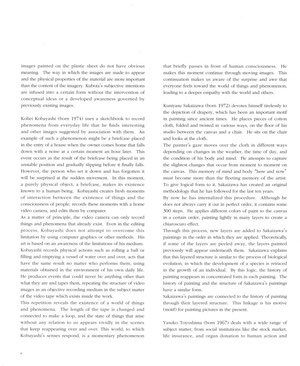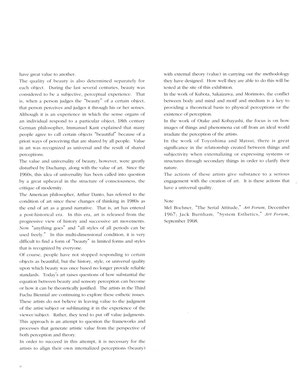The Edge of Image-Somewhere Else, Existing Here
Taro MORIMOTO
The things I paint are very commonplace objects, scenes or figures. I take an image that catches my eye in a printed publication, photograph or film, use a computer to transform it into blocks of color, and further manipulate the image as I convert it into a physical picture.
It’s easy to assume that in this process, I set a certain objective and then work toward it. But during the interval between the original image and the final work, various elements of uncertainty enter in that constantly alter the image, transforming it into something I never imagined.
For example, the original image may be of a landscape somewhere. As I manipulate the image on the computer, all vestiges of the scene’s identity or the significance of its location are stripped away, taking it to a place far from its origin. A succession of clicks leads me to a new image which deserves to be painted on canvas -- an image that still retains some memory of the original landscape, but now expresses something else that was not there before.
The memories triggered by a photograph, for example, are those of the past, but when you look at an altered image, other memories and images are superimposed on it in the present moment. A region on the edge of the image is formed in which new images that transcend time and space flicker in the mind of the viewer. My work is an effort to search along that edge toward a future that exists somewhere.
The edge of the image leads us to a dreamlike place that exists at once here and somewhere else.Like the moment when you find a constellation among the stars, memory triggers the formation of an image from light, and that image in turn calls up memories beyond space and time, in an endless cycle.
April 2012
Translated by Alan Gleason
Statement
Taro MORIMOTO
In a crowded art museum.
Fragments of the body of an angel or goddess in fluent brushstrokes seen from a gap between people.
A glowing woman covered with cracks seen from an oblique angel.
The face of an emperor shining in reflected light.
Even in a situation where it is not possible to think about the age when the picture was painted, enter into it, or continue contemplating it for a long time, the fragments of the image before the eyes are beautiful and make one aware of existing in the present.
Between should exist in the gap between physical substance and image.
2006
from
"The 3rd Fuchu Biennial On Beauty and Value Seven Artists of Post-Bubble Generation"
Fuchu Art Museum, 21 October– 24 December, 2006
Translated by Stanley N. Anderson
critique
Ryoko KAMIYAMA [Curator, Fuchu Art Museum]
"Seeking Beauty and Value Today: The Practice of Seven Artists of the Post-Bubble Generation"
from
"The 3rd Fuchu Biennial On Beauty and Value Seven Artists of Post-Bubble Generation"
Fuchu Art Museum, 21 October– 24 December, 2006
Translated by Stanley N. Anderson





